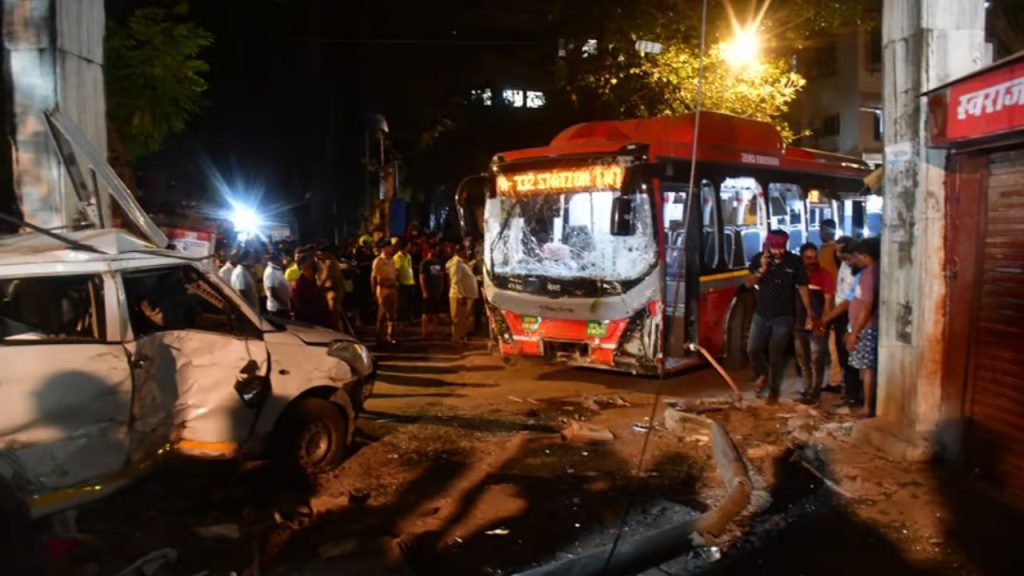
The Tragic Mumbai BEST Bus Crash: Investigating the Causes Behind the Deadly Kurla Mishap
On December 9, 2024, Mumbai witnessed a heartbreaking tragedy when a Mumbai BEST (Brihanmumbai Electric Supply and Transport) bus crashed, claiming the lives of seven people and leaving many others injured. The incident occurred in the Kurla area, one of the city’s busiest and most densely populated locales. The accident shocked the city, leading to widespread discussions about the safety measures in place for public transport, the condition of buses, and the responsibilities of both drivers and passengers.
A Deadly Accident
The deadly mishap took place when a BEST bus, which was traveling along a busy route in Kurla, lost control and collided with a series of vehicles before ultimately crashing into a structure. Eyewitness reports and preliminary investigations suggest that the accident occurred during peak hours, when the roads were crowded with commuters on their way to work or other destinations.
The bus, which was part of the government-run BEST fleet, was filled with passengers. The crash was severe enough to cause fatalities and serious injuries. Seven people lost their lives, and several others were rushed to the hospital for medical treatment, with some sustaining critical injuries.
The Immediate Aftermath
The immediate aftermath of the accident saw a swift response from local authorities and emergency services. Police, fire department personnel, and ambulance teams arrived at the scene quickly to manage the situation. The injured passengers were taken to nearby hospitals, while authorities launched an investigation into the cause of the accident.
The crash not only claimed lives but also raised several pressing questions about the safety of public transportation in one of India’s largest and most populous cities. How could such a tragedy have occurred despite the relatively well-maintained fleet of BEST buses? What factors contributed to this deadly incident?
Factors That Could Have Contributed to the Kurla Mishap
Several factors could have played a role in the Kurla bus crash, including mechanical failure, human error, and road conditions. As the investigation unfolds, the authorities will need to examine all of these possibilities to uncover the root cause of the tragedy. Let’s take a closer look at some of the potential causes of the crash.
1. Driver Error
One of the most common causes of accidents involving public transport vehicles is driver error. In many cases, drivers of buses, cars, and other vehicles are often under pressure to meet strict schedules, which may lead to reckless driving. Drivers may also become fatigued or distracted, especially during long shifts or when they are handling a large number of passengers.
In the case of the Kurla mishap, initial reports suggested that the driver may have lost control of the vehicle. If the driver was speeding or failed to react promptly to a sudden change in traffic conditions, it could have resulted in the bus veering off course. Investigators will likely focus on the driver’s experience, health, and behavior during the incident to determine whether human error played a significant role.
2. Mechanical Failure
Another possibility that could have led to the crash is mechanical failure. Public buses, especially those operating in a densely populated and high-traffic city like Mumbai, are subjected to heavy usage. Over time, wear and tear on the vehicle’s components can lead to malfunctions, which may not always be immediately detectable.
The authorities will likely conduct a thorough inspection of the bus involved in the crash to check for any signs of mechanical issues, such as brake failure, engine problems, or issues with the steering system. If any malfunction is found, it would point to inadequate maintenance or failure to address potential mechanical concerns in a timely manner.
3. Road Conditions
The state of the roads in Mumbai, particularly in areas like Kurla, has been a subject of concern for years. Potholes, poor road infrastructure, and inadequate signage can all contribute to accidents, particularly for large vehicles like buses that require more space and precision to maneuver safely. In the event that the roads were slippery due to rain, poorly maintained, or had unexpected obstructions, it could have further exacerbated the situation, making it difficult for the driver to control the bus.
Additionally, the high volume of traffic in Mumbai, coupled with aggressive driving habits among some drivers, can create chaotic conditions on the roads. Buses, which often navigate crowded routes, may have to make sudden stops or swerve to avoid collisions, increasing the risk of accidents.
4. Passenger Behavior
Another factor that is often overlooked in discussions about bus accidents is the behavior of passengers. In many public transport systems, passengers may be standing, moving around, or crowding near the doors, which can lead to distractions or a lack of attention to safety. If passengers were crowded near the driver or obstructing their view or access to the controls, this could have impaired the driver’s ability to react quickly to changing road conditions.
Moreover, in some cases, passengers might even create a sense of urgency for the driver to speed up or reach their destination faster. This added pressure could cause the driver to make rash decisions, which could ultimately lead to accidents.
5. City Traffic and Congestion
Mumbai is notorious for its heavy traffic and congestion, particularly in areas like Kurla, where commercial, residential, and industrial activities intersect. The combination of narrow roads, inadequate lanes for buses, and the constant flow of vehicles creates a highly challenging environment for public transport drivers. A momentary lapse in concentration or judgment in such an environment can easily result in a catastrophic accident.
The presence of vehicles such as trucks, taxis, motorcycles, and pedestrians in close proximity to buses could have made the Kurla bus’s journey hazardous. In addition, the high number of vehicles on the roads increases the chances of sudden stops or traffic snarls, which may have been a factor in the crash.
Investigation and Accountability
Following the crash, the authorities initiated a detailed investigation to determine the cause of the mishap. The police, along with the BEST management, have focused on reviewing the bus’s maintenance history, the driver’s record, and the road conditions in the area. They will also speak to witnesses and examine CCTV footage from the scene of the accident, which may offer crucial insights into what went wrong.
At the same time, questions are being raised about the adequacy of safety measures and whether the public transport system is prepared to handle the challenges of modern-day Mumbai. Public buses, such as those operated by BEST, must be regularly maintained, and drivers need to be properly trained and monitored to ensure safe operation. Given the scale of the city’s public transport system, the authorities will have to address these concerns to prevent future tragedies.
Conclusion
The tragic Kurla bus crash serves as a grim reminder of the vulnerabilities inherent in public transportation systems, particularly in bustling urban centers like Mumbai. While the investigation is still underway, it is clear that a combination of factors—ranging from human error and mechanical failure to road conditions and passenger behavior—could have contributed to the tragedy. Moving forward, it is essential for authorities to focus on improving safety measures, better infrastructure, and more rigorous oversight to ensure that such incidents do not happen again.
As the families of the victims mourn their loss, the city of Mumbai is left grappling with the aftermath of this heart-wrenching accident. For many, it serves as a somber wake-up call to the ongoing challenges faced by public transport systems in the city, which continue to serve millions of commuters each day.
